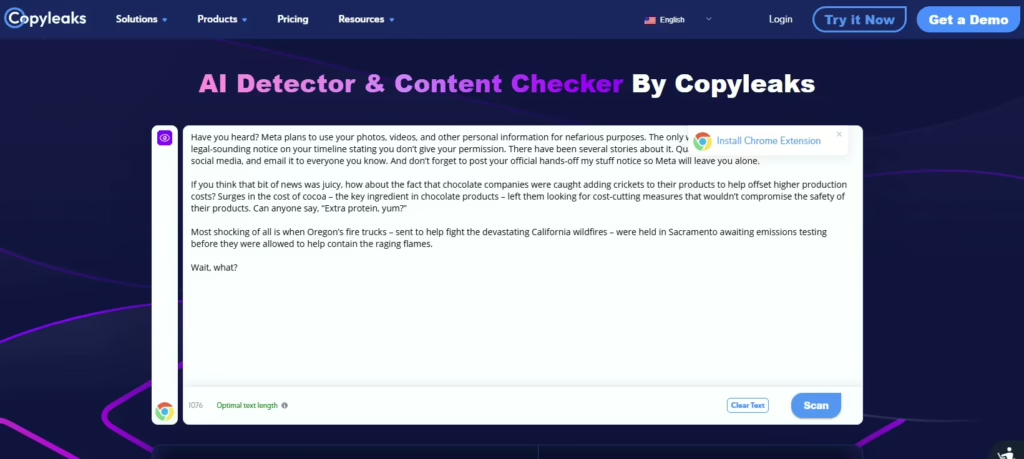Have you heard? Meta plans to use your photos, videos, and other personal information for nefarious purposes. The only way to stop them is to copy and post a legal-sounding notice on your timeline stating you don’t give your permission. There have been several stories about it. Quick! Find one and share it on your social media, and email it to everyone you know. And don’t forget to post your official hands-off my stuff notice so Meta will leave you alone.
If you think that bit of news was juicy, how about the fact that chocolate companies were caught adding crickets to their products to help offset higher production costs? Surges in the cost of cocoa – the key ingredient in chocolate products – left them looking for cost-cutting measures that wouldn’t compromise the safety of their products. Can anyone say, “Extra protein, yum?”
Most shocking of all is when Oregon’s fire trucks – sent to help fight the devastating California wildfires – were held in Sacramento awaiting emissions testing before they were allowed to help contain the raging flames.
Wait, what?
Fake news by the numbers
Before you open your preferred social platform and share any of this dreadful news, you might want to read on a bit. None of the above stories are legitimate, but you’d never know it based on the engagement they’ve received on social media sites.
Fake news is not a new thing. However, it has evolved dramatically since 2020, particularly with the rise of AI-generated content that’s increasingly difficult to distinguish from human-written articles. Fake news has become so sophisticated that some companies like Snopes exist solely to debunk it.
Social media platforms – where the spreading of fake news remains rampant despite years of promised solutions – have implemented various tools designed to help users identify misleading content. Most major platforms now feature information literacy resources, fact-checking partnerships, and algorithmic downranking of known false information. The latest innovations include AI-powered context generators that automatically provide background information on questionable claims.
Search engines have similarly evolved their approaches, with most major players now incorporating trust indicators and source reliability metrics directly into search results. Many have developed separate verified information sections that prioritize content from outlets with established fact-checking protocols.
Fake news by the generation
Even with these technological advances, ultimately, it is still up to consumers to decide whether what they are reading is fact or fiction. According to the latest Digital Media Literacy Survey published in January, 72 percent of Americans polled said they believe fake news is causing deep societal division over basic facts. Another 38 percent admitted they had shared misleading content themselves, knowingly and unknowingly.
Age continues to be a complex factor in the ability to spot fake news, but not in the way many expect. A global study on literature revealed that Gen Z has developed better technical skills for evaluating online sources than older generations. However, they still struggle with newer forms of misinformation, particularly AI-generated content that contains subtle factual distortions. The researchers noted that across all age groups, confirmation bias remains the biggest obstacle to effective information filtering.
Real vs. fake in the AI era
As a trained journalist, I recognize that spotting fake news has become increasingly challenging, even for professionals. Let’s explore some updated methods for determining whether the article you’re reading is legitimate news, based on truth with some misleading facts, or an outright fabrication.
I’m not even going to address the argument about partisan media bias. While it is true that some outlets lean one way or another, that doesn’t automatically mean they are producing fake news. The suggestion that because something came from MSNBC or Fox News makes it fake is still one of my biggest pet peeves. Slanted, maybe. But outright fake? No.
Method #1: evaluate the author
One of the first ways to assess if an article is real or fake news is to look at who wrote it. Is there a byline from a real journalist from a real news outlet on the story? In 2025, this has become more complex thanks to AI. You should also verify if the author exists, as AI-generated fake personas complete with fabricated work histories have become common. Most legitimate journalists now maintain verified digital profiles that link their work across platforms.
Once you’ve confirmed the writer is real, examine their previous work and credentials. Most reputable media outlets include detailed bios and work histories for their professional staff members on their websites. Looking at a writer’s background will help determine if the article is a news piece, an opinion piece, or sponsored content disguised to look like an article.
Method #2: determine the type of article
Among the biggest mistakes most readers still make is failing to recognize under which classification a piece falls. A news article remains defined by its intent to inform readers with verifiable facts. News stories are still not written in the first person, so if you see an article that uses the words I or me (like this blog), it’s likely an opinion piece.
Real news stories include multiple sources, especially when discussing controversial claims. Sources are almost always identified by name and title. While anonymous sources have their place in reputable journalism, any publication that consistently cites anonymous sources and few others is probably not trustworthy.
Remember that facts can always be verified. If you read a story and find yourself doubting it, take time to research the facts before sharing it.
Opinion pieces take many forms and present subjects from the writer’s point of view. An editorial represents the opinion of the media outlet in which it appears. Most media outlets separate opinion pieces from news and features. Columnists like Alexandria Ocasio-Cortez, Matt Yglesias, Bari Weiss, and Andrew Sullivan offer perspectives on current events, but include their opinions. I still regularly see people sharing columns or editorials on social media, mistaking them for objective news reporting.
Sponsored content generally carries some identification, though these labels have become increasingly subtle. Reputable media outlets take care to properly identify these story-like advertisements, but the lines continue to blur as native advertising becomes more sophisticated. Just remember that sponsored content is written from the advertiser’s perspective.
Method #3: sort satire from fact
It’s difficult to discern spoofed news from factual articles since so much about the world we live in is considered “unprecedented” these days.
Satire sites like The Onion continue to produce parody content. These sites are intended to be humorous and typically don’t hide their satirical nature. However, some readers still occasionally mistake them for legitimate news.
The AI misinformation challenge
Perhaps the most significant evolution in fake news since 2020 is the rise of AI-generated content. While artificial intelligence has created remarkable opportunities across many fields, it has also introduced new complications for information literacy.
Today’s AI writing tools can produce articles that are virtually indistinguishable from human-written content in terms of style and structure. However, these systems have a troubling tendency to include what experts call hallucinated facts – information that appears plausible but is completely fabricated. Unlike human writers who typically need to research false claims before including them, AI can effortlessly generate convincing falsehoods without hesitation.
The challenge with AI-generated misinformation isn’t just its volume, but its confidence. When AI presents false information with the same authoritative tone as accurate details, it can mislead even the most careful readers. These errors range from subtle – like misattributing quotes to the wrong researcher or citing papers that don’t exist – to substantial fabrications of entire events, studies, or statistics. What makes these errors particularly pernicious is that they’re often mixed with accurate information, making the fabrications harder to spot.
How news organizations use AI
Some news organizations have experimented with AI-assisted reporting. However, responsible outlets maintain human oversight throughout the process. Unfortunately, less scrupulous websites have embraced fully automated content generation to produce high volumes of clickbait articles with minimal investment.
The information laundering cycle has also intensified. AI-generated falsehoods published on obscure websites get picked up by larger outlets, gaining credibility with each republication. By the time fact-checkers intervene, the misinformation has often reached millions through algorithmic amplification.
AI content checker tools
Several detection tools have emerged claiming to identify AI-written content. However, these remain locked in a technological arms race with increasingly sophisticated generation methods and inconsistent results. Many experts now recommend focusing less on identifying whether content was AI-generated and more on verifying the underlying facts, regardless of the author.
For consumers, the best defense remains practicing critical information consumption. Check multiple sources, verify claims against established knowledge, and maintain a healthy skepticism toward content that triggers strong emotional reactions or confirms existing biases too conveniently.
Some digital literacy experts also recommend the “SIFT” method:
- Before you feel pressured to share digital news (especially if it’s juicy), take the time to verify whether it’s factual. You don’t want to propagate the rapid spread of fake news.
- Investigate the Source. Even if a trusted friend has shared something on their social feed, do a web search to verify if the source of the information they shared is reputable.
- Find Better Coverage. If you’ve never heard of the source pushing out news about something, check if other well-known sources (including fact-checking services) have published something similar.
- Trace Claims to their origins. This is often a natural part of finding better coverage, at least if you’re using my recommended methods. Consider this the onion phase of SIFT. Keep peeling back the layers until you find the source, no matter how many times it’s been reported by different outlets.
The technology behind fake news will continue evolving. The fundamental principles of information literacy remain our most powerful tools against misinformation, whether it’s human-generated or AI-generated.
Dangerous disguises in the digital age
AI isn’t the only source of incorrect information. Some online outlets have perfected the art of disguising themselves as legitimate sources, and the techniques have grown more sophisticated in recent years.
Website spoofing remains one of the most effective tactics in the misinformation ecosystem. Bad actors create sites that mimic the appearance, layout, and domain naming patterns of established news organizations, often with subtle changes to URLs that many readers overlook. These spoofed sites may use slightly modified domain names (adding words like daily, news, or world), alternative domain extensions (.co instead of .com), or additional characters that are easy to miss at a glance.
What makes modern spoofing particularly dangerous is the integration of AI-generated content that matches the writing style and formatting of legitimate publications. These sites now feature convincing reporter profiles with AI-generated faces, fabricated work histories, and even false social media presences that appear authentic under cursory examination.
According to cybersecurity researchers, sophisticated spoofing operations can generate significant revenue through programmatic advertising, cryptocurrency donations, and affiliate marketing schemes. Some of the most successful networks have been traced to international operations specifically designed to evade regulatory oversight by operating across multiple jurisdictions.
Handy methods for spotting fake news sites
One of the most effective methods for verifying digital news sites is examining the website domain on which an article appears. Even when a site looks professional – complete with convincing logos and design – it may not be trustworthy. Tools like ICANN’s WHOIS database have become more limited due to privacy regulations, but domain age checkers and media bias charts can provide valuable context. Many browsers now offer built-in extensions that automatically display trust scores for news websites you visit.
Another critical verification method involves cross-referencing information across multiple trusted sources. If a shocking story appears on only one website or across a network of similar-looking sites, that’s a major red flag. Most legitimate breaking news will be covered by multiple established outlets, even if with different angles.
If you’re like most people, all of this is enough to make your head hurt. Sadly, it’s a sign of the times in which we live, and consumers can never assume that something is legitimate just because it appears professional or aligns with their existing beliefs.
Staying ahead in the battle against misinformation
It’s not going to get any easier to distinguish fact from fiction. The sophistication of fake news, the proliferation of AI-generated content with factual inaccuracies, and the blurring lines between news and opinion demand a heightened level of media literacy.
While technology companies and social platforms have implemented various safeguards, the ultimate responsibility for information verification falls on each of us. Developing critical evaluation skills, cross-checking information across multiple reputable sources, and maintaining a healthy skepticism remain our best defense against fake news.
The stakes are even higher for businesses and organizations. Publishing inaccurate information doesn’t just spread misinformation. It can irreparably damage your brand’s credibility and reputation. In an era where trust is a precious commodity, factually accurate and ethically produced content is non-negotiable.
Don’t risk your reputation with AI-generated content that might contain factual errors or content created by inexperienced writers unfamiliar with journalistic standards. Invest in quality content creation to build trust with your audience and position your brand as a reliable voice in a sea of misinformation.
Have you ever knowingly or unknowingly shared fake news on social media? What methods do you use to decide if something is legitimate? I’d love to hear about it in the comments section.



